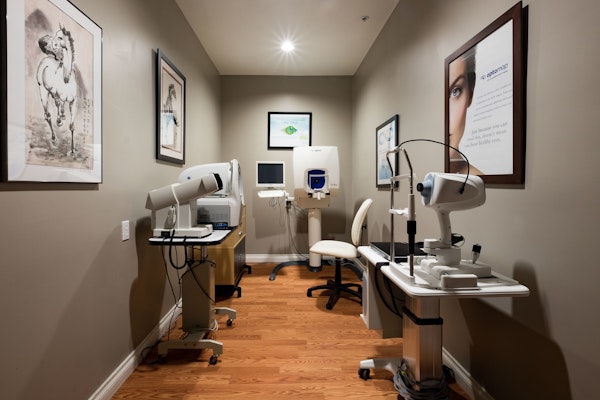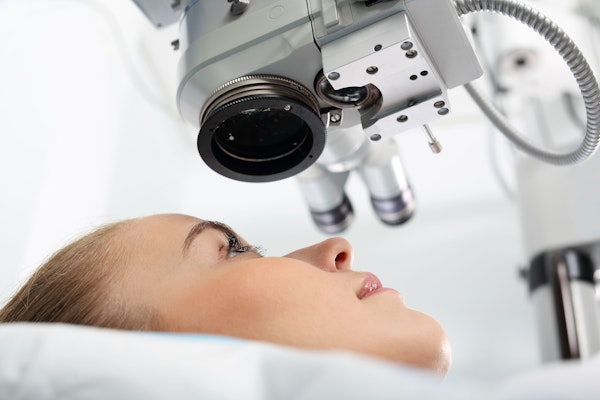
Farsightedness
Struggling to read a book or use the computer can be frustrating and uncomfortable. Fortunately, farsightedness is easily manageable.
Farsightedness, or hyperopia, is a vision condition that occurs when light cannot focus properly, causing up-close objects to appear blurry.
How do I know if I’m farsighted?

Common Signs of Hyperopia to Watch For
Difficulty Seeing Close-Up Objects Clearly
You may notice that focusing on nearby objects becomes more difficult over time. This can affect your ability to read, use the computer, or complete other activities that require attention to fine details.
Supplementing Impaired Vision by Squinting
Many patients notice themselves squinting more often to see close-up objects or to read. Squinting only allows a small amount of light in, bending light into the proper focus.
Discomfort after Prolonged Up-Close Activities
You frequently experience headaches and eyestrain, which feels like burning or aching in or around the eyes, after reading, using the computer, or engaging in other activities that require up-close focus.
Genetics & Pregnancy Factors Can Increase Your Risk
Hyperopia is believed to be a genetic condition. If either of your parents is farsighted, you are much more likely to develop the condition over your lifetime. You may also be at a higher risk if your mother smoked while pregnant or you were born prematurely.
Now, let's discuss what directly causes farsightedness...
Why are Close Objects Blurry?
Your Cornea Is Not Properly Curved
If your cornea does not curve normally, a refractive error occurs. A misshapen cornea or lens prevents light from entering the eye correctly.
Your Eye Is Too Short
If your eyeball is not long enough, the light cannot travel far enough to focus properly, causing close up images to appear blurry.
Farsightedness Can Develop with Age
Presbyopia, or age-related farsightedness, is common among patients over 40 years old due to loss of elasticity in the lens. By 2020, it is predicted that over one billion people worldwide will suffer from presbyopia.
"Regular eye exams are the cornerstone of visual health as people age. Individuals who have a family history of eye disease or other risk factors should have more frequent exams." Harvard Health Publishing
You can Minimize the Side Effects of Farsightedness
Have Your Eyes Checked Regularly
While farsightedness is not preventable, you can monitor your sight by attending regular exams. By identifying the problem early on, the doctor can provide you with treatment solutions to restore proper vision.
Rest Your Eyes
Continuous use of your eyes, such as long hours on the computer or reading small print, can cause eye strain. Taking regular breaks can help with discomfort. The 20-20-20 rule recommends looking at something 20 feet away for 20 seconds for every 20 minutes of up-close focus. Blinking can also be helpful.
Try Eye Exercises
Several eye exercises can help rehydrate the eye and provide a break for muscles. Methods such as flutter blinking, palming, where the eyes are covered by your palms for several minutes, or stretching, moving the eyes around in specific patterns, can help with focus and discomfort.
Your Doctor Can Identify Hyperopia During Your Eye Exam
The doctor can conduct several standard tests to identify any refractive errors such as hyperopia. First, you will complete a visual acuity test which uses a chart set 20 feet away to determine the smallest letters you are able to read. The doctor can then have you try on various lens prescriptions until you can read the chart clearly.

A doctor is performing a series of tests to determine if this patient is farsighted.
If the doctor believes you may suffer from farsightedness, he may also conduct several further tests. This may include a dilated eye exam and a slit lamp exam, among others.
Conservative & Surgical Treatment Options
Corrective Eyewear
For many patients, corrective eyewear including glasses and contacts, can provide sufficient, affordable vision correction. This treatment option is typically recommended for children and younger patients as their natural lenses are more flexible and can better accommodate the issue.
Laser Eye Surgery
If you want a long-term solution that frees you from the burden of contacts or glasses, laser vision correction such as LASIK or PRK may be a better option. These procedures correct the refractive error by reshaping the cornea. Many patients experience significantly improved vision that allows them to minimize their reliance on corrective eyewear.
Your Doctor Can Help
While experiencing blurry vision may seem overwhelming, farsightedness is very common and can be corrected with the help of your doctor. If you are having difficulties reading or using the computer, schedule an eye exam with your doctor to evaluate your vision for signs of hyperopia. They can work with you to provide effective treatment so you can see clearly once again.







